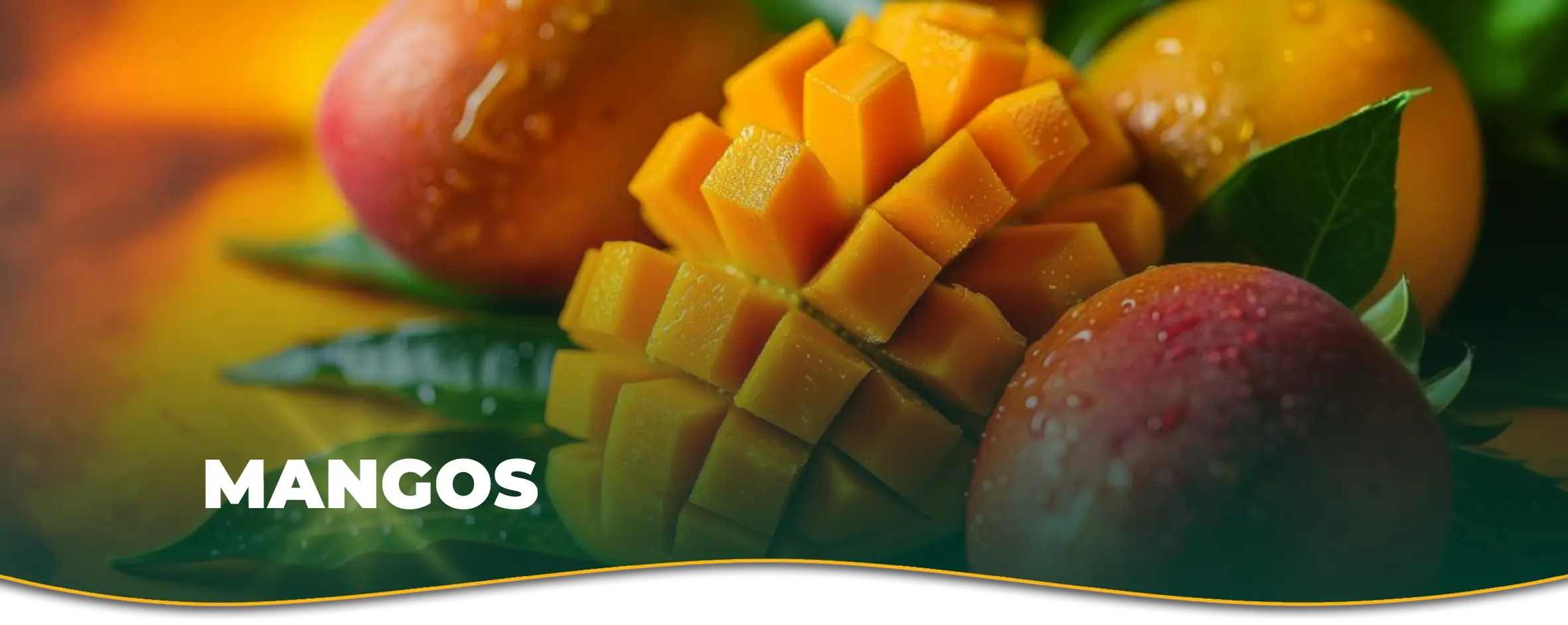
Mangos
Egypt is quite famous and proud of producing over 120 different kinds of mangoes and is celebrated for its vibrant flavors, varied textures, and rich aroma. Cultivated in the country’s fertile regions, these tropical fruits come in several varieties, each with distinct characteristics. From the sweet and creamy Zebda to the tangy and aromatic Siwi, Egyptian mangoes offer a delightful array of choices for fruit enthusiasts. Their smooth skin and juicy flesh make them a popular choice for fresh eating, culinary dishes, and beverages.

- Zebda Mango: Renowned for its large size and vibrant yellow skin, the Zebda mango is prized for its exceptionally sweet and creamy flesh. Its deep taste makes it preferable for fresh eating and smoothies. The Zebda variety is typically harvested from June to September, during Egypt’s mango season.
- Siwi Mango: Named after the Siwa Oasis, this variety is known for its smaller size and distinctive aroma. The Siwi mango has a greenish-yellow skin with a slightly tangy taste that adds a unique twist to salads and desserts. It is usually available from June to August.
- Asha Mango: Asha mangoes are recognized for their bright orange skin and juicy, fiberless flesh. This variety is known for its sweet, aromatic flavor and smooth texture, making it ideal for eating fresh or using in culinary dishes. Harvested from July to October, Asha mangoes are a popular choice for both local consumption and export.
- Langra Mango: Though not native to Egypt, the Langra variety is cultivated in certain regions due to its high demand. It features a green skin even when ripe and a slightly tangy flavor that balances sweetness. Langra mangoes are available from June to September and are favored for their distinctive taste and texture.
- Tommy Atkins Mango: This variety is characterized by its reddish-orange skin and firm flesh. The Tommy Atkins mango has a mildly sweet flavor with a slight tang, making it versatile for various culinary applications, including salads and salsas. Its harvest season is from June to September.
- Mabrouka Mango: This variety is known for its small to medium size and distinctive sweet-tart flavor. The Mabrouka mango has bright yellow skin with a slightly greenish tinge, and its tender, juicy flesh is perfect for making fruit salads and desserts. Available in the markets from July to September.
- Hims Mango: Recognized for its round shape and vibrant yellow-orange skin, the Hims mango is prized for its rich, sweet flavor and minimal fiber. The smooth, juicy flesh makes it an excellent choice for fresh eating and smoothies. Hims mangoes are generally harvested from June to August.
- Kesar Mango: Although originally from India, the Kesar variety is also cultivated in Egypt. Known for its small size and deep orange color, Kesar mangoes have a sweet, aromatic flavor and a non-fibrous texture. They are typically available from June to September and are popular for their rich taste and fragrance.
- Anwar Mango: The Anwar mango is a lesser-known variety that stands out for its distinctive sweetness and slightly tangy undertones. It has yellow skin with a tinge of red and a juicy, smooth texture. This variety is usually harvested from June to August and is enjoyed for its balanced flavor.
- Naomi Mango: Rich in vitamins C and A, dietary fiber, and antioxidants, Naomi mangoes support immune health, vision, and digestion, and offer protection against oxidative stress. planted in early spring and are typically harvested from late summer to early autumn, from July to September, in warm, sunny climates.
Mangoes are packed with essential nutrients, making them a nutritious addition to your diet. Mangoes are high in vitamins such as A and C, which are essential for maintaining bright healthy skin, sharp vision, and immune system. Mangoes also provide dietary fiber, which supports digestive health and helps prevent constipation. Additionally, they contain potassium, which aids in maintaining healthy blood pressure levels, and antioxidants, which help combat oxidative stress and inflammation in the body.
Mango trees are typically planted in early spring when temperatures start to rise. They grow in hot and sunny climates with fertile soil. The fruit begins to develop during the warmer months and is usually ready for harvest from late spring to early autumn. The specific harvest season can vary depending on the variety, with many Egyptian mangoes being available from June to September. During the harvest period, the fruit is carefully picked at its peak ripeness to ensure the best flavor and texture.
